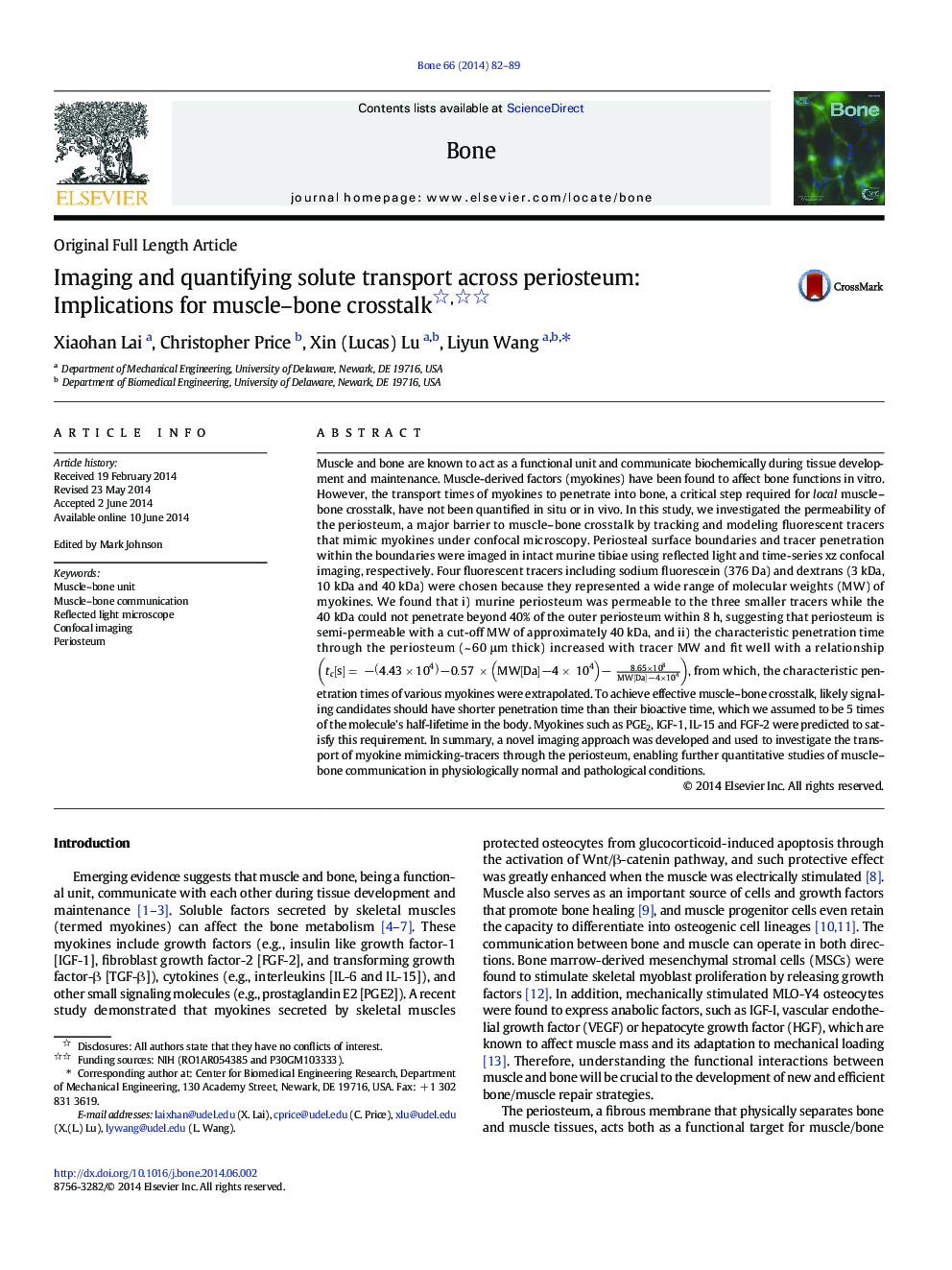| کد مقاله | کد نشریه | سال انتشار | مقاله انگلیسی | نسخه تمام متن |
|---|---|---|---|---|
| 5890185 | 1568153 | 2014 | 8 صفحه PDF | دانلود رایگان |

- A novel imaging approach was developed to characterize the transport of myokine-mimicking tracers across murine tibial periosteum.
- Periosteal boundaries and tracer penetration were measured in situ with reflected-light and confocal time-series imaging, respectively.
- Periosteum was found to be semi-permeable, allowing penetration of 376Â Da-sodium fluorescein and 3Â kDa- and 10Â kDa-dextrans while blocking that of 40Â kDa-dextran.
- The characteristic penetration time (tc) through periosteum was found to increase with tracer molecular weight (MW):tcs=â4.43Ã104â0.57ÃMWDaâ4Ã104â8.65Ã108MWDaâ4Ã104.
- Candidates for muscle-bone crosstalk (PGE2, IGF-1, IL-15 and FGF-2) were identified by comparing their predicted periosteal penetration and bioactive times.
Muscle and bone are known to act as a functional unit and communicate biochemically during tissue development and maintenance. Muscle-derived factors (myokines) have been found to affect bone functions in vitro. However, the transport times of myokines to penetrate into bone, a critical step required for local muscle-bone crosstalk, have not been quantified in situ or in vivo. In this study, we investigated the permeability of the periosteum, a major barrier to muscle-bone crosstalk by tracking and modeling fluorescent tracers that mimic myokines under confocal microscopy. Periosteal surface boundaries and tracer penetration within the boundaries were imaged in intact murine tibiae using reflected light and time-series xz confocal imaging, respectively. Four fluorescent tracers including sodium fluorescein (376 Da) and dextrans (3 kDa, 10 kDa and 40 kDa) were chosen because they represented a wide range of molecular weights (MW) of myokines. We found that i) murine periosteum was permeable to the three smaller tracers while the 40 kDa could not penetrate beyond 40% of the outer periosteum within 8 h, suggesting that periosteum is semi-permeable with a cut-off MW of approximately 40 kDa, and ii) the characteristic penetration time through the periosteum (~ 60 μm thick) increased with tracer MW and fit well with a relationship tcs=â4.43Ã104â0.57ÃMWDaâ4Ã104â8.65Ã108MWDaâ4Ã104, from which, the characteristic penetration times of various myokines were extrapolated. To achieve effective muscle-bone crosstalk, likely signaling candidates should have shorter penetration time than their bioactive time, which we assumed to be 5 times of the molecule's half-lifetime in the body. Myokines such as PGE2, IGF-1, IL-15 and FGF-2 were predicted to satisfy this requirement. In summary, a novel imaging approach was developed and used to investigate the transport of myokine mimicking-tracers through the periosteum, enabling further quantitative studies of muscle-bone communication in physiologically normal and pathological conditions.
Journal: Bone - Volume 66, September 2014, Pages 82-89